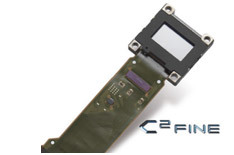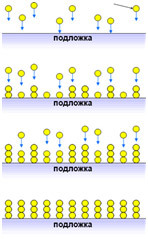Epson Crystal Clear Fine vs Conventional Matrix
 We said earlier that all Epson projectors use the three-matrix Epson 3LCD technology for imaging . Using three LCD matrices at once provides a number of advantages, including:
We said earlier that all Epson projectors use the three-matrix Epson 3LCD technology for imaging . Using three LCD matrices at once provides a number of advantages, including:- allows you to significantly increase the projector's light output and color brightness;
- better energy efficiency since red, green and blue image components are formed simultaneously, and not in turn, as in single-matrix projectors;
- guarantees the complete absence of the "rainbow effect" inherent in single-matrix projectors (for example, on DLP technology);
- provides higher reliability due to the absence of moving mechanical elements, such as rotating light filters and rotating micromirrors on the matrices of DLP projectors (except for fans in the cooling system).

Special attention should be paid to the matrices used in 3LCD projectors. Compared with the matrices of monitors and TVs, they are presented with fundamentally higher requirements, both in miniature and in resistance to high temperatures. Recognizing this fact, we nevertheless return to the question: what type of matrices is used in Epson projectors?
So different LCD
In previous articles, we wrote that Epson projectors can be equipped with two types of matrices: “ standard ” and “ C2 Fine ”. The latter are used in more expensive home theater projectors and installation projectors. What is the difference?
Readers who have studied the choice of a monitor know that there are three main technologies for LCD-matrixes (not counting their modifications) - TN, IPS, VA. Epson projectors of the initial price group use TN matrices , while more expensive models use matrices based on Crystal Clear Fine (C2 Fine) technology, which combines a VA matrix with the so-called “inorganic orienting layer”.

In most cases, VA technology provides higher contrast than any other, including IPS. In this case, the contrast of VA matrices is an order of magnitude higher than that of TN matrices. The main drawback of VA technology is its small viewing angles, which is not important in the case of projectors, since the matrix's task is to transmit (or delay) a beam of light directed strictly perpendicularly.
Contrast, contrast ...
Let’s see how exactly the higher contrast of the VA matrices is achieved. The principle of LCD matrices is basically the same: we have a “sandwich” - liquid crystals sandwiched between two filters with different polarizations. 50% of the light is blocked by the first filter, the remaining 50% by the second. Thus, if there were no liquid crystals between the filters, then the light would be completely blocked (well, almost).
As for liquid crystals, when a voltage is applied to a specific pixel, a magnetic field is created, under its influence, the crystals try to rotate 90 degrees from their original position. And what is their initial position?
In TN matrices, the crystals are initially perpendiculara stream of light - in this position they change the polarization of the light passing through them and the second polarizing filter begins to pass it. Thus, in the absence of voltage, the matrix shows a white screen. When energized, the liquid crystals rotate 90 degrees to stand upright.

In this position, they do not affect the polarization of light and the light is completely blocked by the second filter. In reality, liquid crystals cannot be located absolutely vertically, therefore a partial polarization of the light passing through them occurs, and therefore the second filter cannot completely block it. In other words, there is a slight light leak when displaying black.
VA (vertical alignment) technology assumes that the liquid crystals are initially (in the absence of voltage) aligned vertically without affecting the polarization of the light, which is effectively blocked by filters and does not leak through the matrix.

When voltage is applied, the crystals rotate parallel to the matrix surface, but again not completely - there is a slight decrease in the maximum matrix bandwidth (and projector brightness). Separately, it is worth mentioning that for the orientation of liquid crystals an inorganic orienting layer is used , which is produced in a non-contact way:

The thickness of the leveling layer is controlled at the molecular level and provides excellent uniformity of orientation of liquid crystals, which is extremely positive for both contrast and image uniformity. For TN matrices, the orientation layer is applied with a special roller, which gives a slightly less uniformity of the orientation layer.
Entertaining Arithmetic
We have indicated that when using VA technology, the black level will be lower (“darker”, “deeper”). But how does this affect contrast, that is, the ratio of white to black? Indeed, with a VA-matrix, together with a “deeper” black color, we got a decrease in maximum brightness.
As an example, suppose that in the initial position, liquid crystals are 100% effective. In other words, with TN they transmit 100% of the light, while with VA they block 100% of the light. When turning, the efficiency drops, suppose, to 90% - the TN matrix blocks 90% of the light, VA - transmits 90% of the light. We can determine the contrast: for the TN matrix it will be 100% / 10% = 10: 1, and for the VA matrix it will be 90% / 0% (infinite). The example, although abstract, emphasizes how strongly the black level affects the resulting contrast ratio.
As a result
As a result, higher contrast of more expensive Epson projectors is achieved due to the initially “black” position of the matrix, in which liquid crystals are oriented strictly parallel to the light stream. They are assisted by an inorganic orienting layer, which also provides high uniformity of brightness and color reproduction of the image. To this it is worth adding that projectors with C2 Fine matrices are usually equipped with an automatic iris , which allows you to get a very deep black color in dark scenes, giving the industry the best contrast ratios. For example, the Epson EH-TW9200 projector boasts a dynamic contrast ratio of 600,000: 1, which, of course, is only one of its advantages.

And if you want to get absolute (without exaggeration) contrast from the projector, we recommend paying attention to the Epson EH-LS10000 - the first home laser projector Epson, which we talked about in this post . The matrix of this projector does not work on light, but on reflection. Hence the name of the technology is 3LCD Reflective.
We will talk about Epson 3LCD Reflective in one of the following posts.
